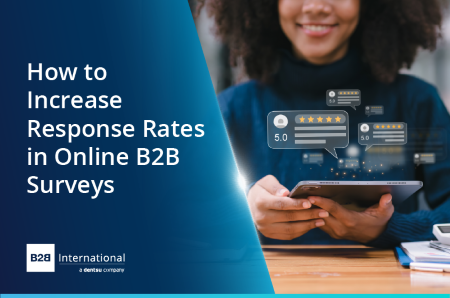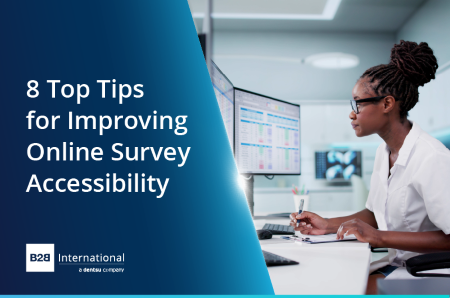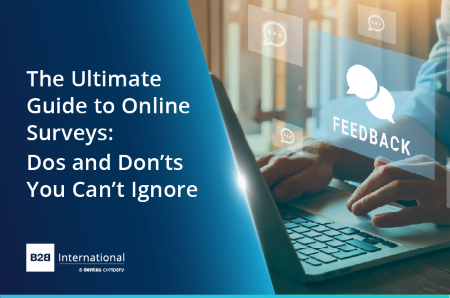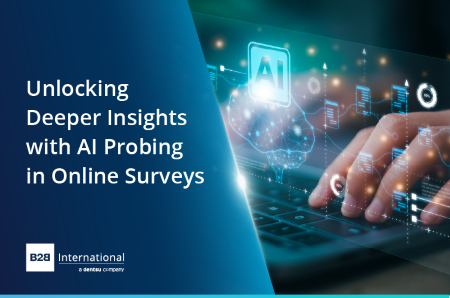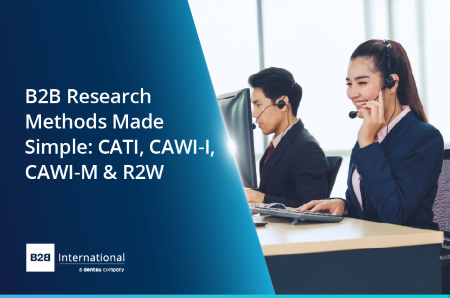
In B2B research, how you reach your audience is just as critical as what you ask them. The right methodology ensures you connect with the right people, gather meaningful insights, and deliver actionable outcomes.
At B2B International, we partner with organizations across sectors – from industrial manufacturers to SaaS providers – and understand that each research method comes with its own practical considerations. Below, we evaluate the pros and cons of distinct quantitative data collection methods (excluding online panels), and when to use each.
📞 CATI – Computer-Assisted Telephone Interviewing
What it is:
A trained interviewer conducts the survey over the phone, following a structured script and entering responses directly into a system.
Best used when:
- Your audience is offline or deskless (e.g. tradespeople, field engineers).
- You have access to a targeted phone list.
- You need to reach senior decision-makers not found on panels.
Advantages:
- No internet required.
- Direct, personal engagement with opportunities for probing and prompting.
- Effective for hard-to-reach or traditional audiences.
Challenges:
- Call screening and scheduling difficulties.
- Limited ability to show visual stimuli.
- Less suited for complex or interactive tasks.
🌐 CAWI-I – Online Survey with Active Interviewer Support
What it is:
A web-based survey conducted with real-time interviewer guidance via video call or phone. The interviewer inputs the responses.
Best used when:
- The survey is complex or requires explanation (e.g. pricing models, product features).
- You want to ensure accuracy and engagement.
- Your audience is online but may need support.
Advantages:
- Combines digital convenience with human support.
- Ideal for advanced methodologies like conjoint or simulations.
- Direct communication allows for probing and prompting.
- Enhances data quality through clarification.
Challenges:
- Requires scheduling and tech readiness.
- Less scalable due to the one-on-one format.
💻 CAWI-M – Online Survey with Passive Interviewer Monitoring
What it is:
Respondents are initially phoned for recruitment and complete the survey independently. An interviewer or quality assurance person is available in the background to assist if needed.
Best used when:
- You want to avoid bias in a mixed-method project (e.g. branding studies).
- You want to reduce dropouts or misinterpretation.
- You’re testing reactions to content (e.g. marketing materials).
- You need light-touch oversight without full facilitation.
Advantages:
- Balances autonomy with quality control.
- Respondents can complete complex tasks but request support if needed.
- Interviewers can monitor multiple interviews simultaneously, lowering resource requirements.
Challenges:
- Relies on respondents to request help.
- Tech issues may still hinder completion.
👥 R2W – Recruit-to-Web: Verified Respondents for Online Surveys
What it is:
A tailored recruitment approach that identifies and verifies individuals from your target audience to complete online self-completion surveys. Unlike panels, R2W ensures respondents are handpicked and relevant.
Best used when:
- Your audience is niche, high-value, or not on panels.
- You need verified participants for robust data quality.
- You’re running surveys with complex tasks (e.g. MaxDiff, Conjoint).
Advantages:
- Precision targeting of hard-to-reach segments.
- High-quality, verified respondents.
- Suitable for sensitive or high-stakes topics.
Challenges:
- Recruitment takes time and effort.
- Requires multi-channel outreach (e.g. LinkedIn, desk research).
- Higher cost due to over-recruitment and scheduling needs.
Choosing the Right Method
At B2B International, we don’t default to the cheapest or fastest method – we choose the one that best fits your audience, objectives, and operational realities.
- Need scale and speed? CATI or CAWI-M are efficient and scalable.
- Running complex exercises? CAWI-I or R2W offer control and clarity.
- Targeting niche or offline audiences? R2W or CATI are your best bets.
- Want to balance quality and flexibility? CAWI-M provides a smart middle ground.
Method Comparison Matrix
| Benefit | CATI | CAWI-I | CAWI-M | R2W |
|---|---|---|---|---|
| Reach people not regularly online | ✮ | ✔ | ✔ | ✔ |
| Personal interaction | ✔ | ✔ | ✔ | ✔ |
| Ability to clarify questions in real-time | ✔ | ✔ | ✔ | ✔ |
| Suitable for complex tasks (e.g. conjoint) | ✔ | ✔ | ✮ | ✔ |
| Flexible for respondent’s schedule | ✔ | ✔ | ✔ | ✮ |
| Low technical requirements for respondent | ✔ | ✔ | ✔ | ✔ |
| Reaches niche or hard-to-find audiences | ✮ | ✔ | ✔ | ✔ |
| Allows in-depth qualitative discussion | ✮ | ✮ | ✖ | ✖ |
| Monitoring response quality live | ✔ | ✔ | ✔ | ✖ |
| Scalable to larger sample sizes | ✔ | ✔ | ✔ | ✔ |
Key:
✮ – Market-leading approach
✔ – Very strong approach
✔ – Good approach but another is better
✖ – Challenging to achieve, but not impossible
Final Thought
At B2B International, we don’t just deliver data – we deliver confidence. Our expertise lies in selecting the right research method to match your audience, objectives, and operational realities. Whether you’re navigating niche markets, testing complex propositions, or scaling insights across regions, we tailor our approach to ensure you get the clarity and confidence to act.
Readers of this article also viewed:
How to Increase Response Rates in Online B2B Surveys 8 Tips for Improving Online Survey Accessibility for People Affected by Sight Loss The Role of Synthetic Data in B2B Market Research The Ultimate Guide to Online Surveys: Dos and Don’ts You Can’t Ignore Addressing the Problem with Data Quality in B2B Research Unlocking Deeper Insights with AI Probing in Online Surveys How to Maximize the Value of Telephone Interviews in B2B Research
To discuss how our tailored insights programs can help solve your specific business challenges, get in touch and one of the team will be happy to help.


